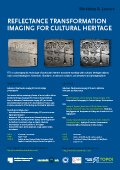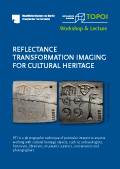Reflectance Transformation Imaging (RTI) is an emerging advanced imaging technique for the documentation and research of cultural heritage. It is a low-cost and user-friendly computational photographic method that captures a subject’s surface shape and color and enables the interactive re-lighting of the subject from any direction. RTI also permits the mathematical enhancement of the subject’s surface shape and color attributes. The enhancement functions of RTI reveal surface information that is not disclosed under direct empirical examination of the physical object. RTI is of particular interest to anyone working with cultural heritage objects, such as archaeologists, historians, librarians, museums curators, conservators and photographic staff.
This evening event will be comprised of three parts, a lecture and two talks. The lecture, delivered by Mark Mudge and Carla Schroer of Cultural Heritage Imagining (CHI) will present recent work in computational photography as it relates to cultural heritage. Reflectance Transformation Imaging, Algorithmic Rendering, Multi-spectral imaging, and Photogrammetry examples will be shown.
The two talks will detail the application of one particular type of computational photography, namely Reflectance Transformation Imaging (RTI). Kathryn Piquette will present a case study focusing on the use of RTI as documentation for small finds during archaeological excavation. She will also briefly detail how the use of RTI data is informing her research on early Egyptian and Near Eastern writing and art objects in museum collections, and the new insights that can be gleaned by exploiting this powerful imaging technology. Cornelia Kleinitz will present a case study on the use of RTI for the documentation of ancient graffiti at Musawwarat es Sufra in Sudan. She will focus on the advantages and disadvantages of applying Highlight RTI to an extensive body of intricate material in difficult field conditions. She will also compare these results with those of other, previously applied imaging techniques, such as photography, direct tracing and structured light scanning.
The lecture and talks will be followed by a wine reception. RTI equipment and images will be on display. Researchers, students, and anyone interested in learning more about RTI are warmly invited to examine the equipment and discuss ideas with the speakers.
This event is jointly hosted by Excellence Cluster Topoi and Staatliche Museen zu Berlin – Stiftung Preußischer Kulturbesitz, Ägyptisches Museum und Papyrussammlung. We extend a cordial invitation to anyone interested in attending.
Please register in advance at http://rti-lecture.eventbrite.co.uk/
22.10.2012 | |
19:00 - 19:40 | Computational Photography for Cultural Heritage Documentation Mark Mudge Carla Schroer |
19:40 - 20:00 | Visualising Early Egyptian and Mesopotamian Writing and Art with the Aid of Highlight RTI Kathryn E. Piquette |
20:00 - 20:20 | Highlight RTI and the Documentation of Ancient Graffiti at Musawwarat es Sufra (Sudan) Cornelia Kleinitz |


